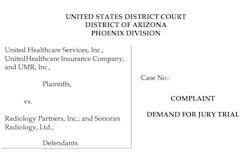Malpractice factors are tied to imaging use for emergency department patients who present with headaches, according to research published October 29 in the American Journal of Roentgenology.
A team led by Casey Pelzl from the Harvey L. Neiman Health Policy Institute in Reston, VA, found that certain state-level legislative measures showed significant independent associations with less imaging overall in these patients.
These trends are “possibly representing reductions in defensive medicine practices related to state-level tort reform measures,” Pelzl and colleagues highlighted.
The American College of Radiology (ACR) Appropriateness Criteria recommend that advanced imaging should only be performed for certain presentations of headache in the emergency department. However, prior research suggests that imaging in this area has grown in use. The researchers wrote that this may be due to defensive medicine practices and medicolegal concerns.
Some states have implemented tort reform legislative measures to reduce frivolous malpractice suits. These include damage caps, which put limits on financial compensation amounts for plaintiffs, and several liability, where defendants in a malpractice case are responsible only for damages they directly cause.
Pelzl et al investigated potential links between imaging use in patients presenting to the emergency department with headache and state-level malpractice measures, using Medicaid data. The study included 630,227 emergency department encounters in 2019.
The team reported national per-encounter imaging use for the following: imaging overall (39.1%), CT (38.1%), CT angiography (CTA, 2%), and MRI (1.1%).
The group's analysis showed that overall imaging was independently less likely in the presence of a greater average malpractice payment (odds ratio [OR] per $10,000 = 0.99), damage caps (OR = 0.79), and several liability (OR = 0.68). Overall imaging, however, was not independently tied to premiums per capita or loss and defense costs per capita.
Having a referring physician specialty other than emergency medicine physician showed the strongest independent association with greater use of imaging overall (OR = 8.45). And facilities with less than 100 beds had the strongest independent association with decreased imaging overall (OR = 0.65).
Finally, the researchers identified the following additional independent associations between malpractice factors and imaging use: decreased CT use for a greater average malpractice payment (OR per $10,000 = 0.98), damage caps (OR = 0.87), and several liability (OR = 0.78); decreased CTA use for a greater premium per capita (OR per $1 = 0.98) and several liability (OR = 0.57); increased CTA use for greater loss and defense costs per capita (OR per $1 = 1.03); and decreased MRI utilization for several liability (OR = 0.71).
Despite the results, the authors cautioned that other confounding factors could have contributed to the associations observed in the study.
“Indeed, malpractice measures and imaging utilization showed varying associations across the spectrum of conducted analyses,” they wrote. “Additional factors, including triage efficiency prioritization and guideline adherence, heavily inform provider decision-making.”
Read the entire study here.




















